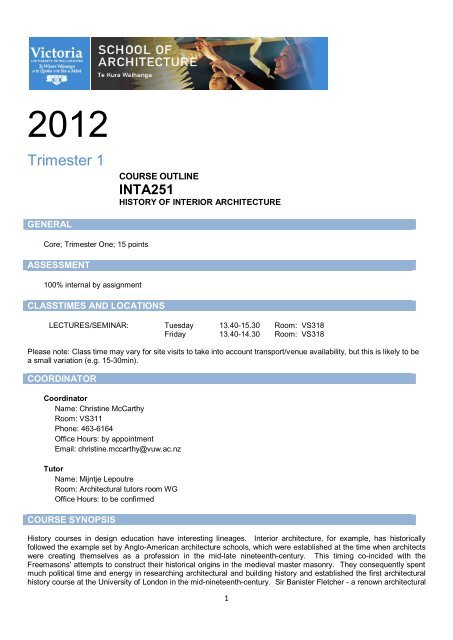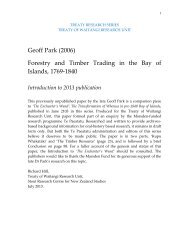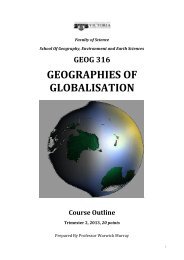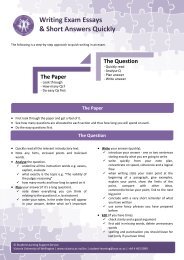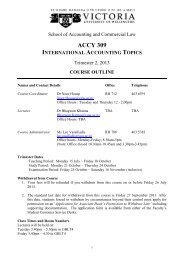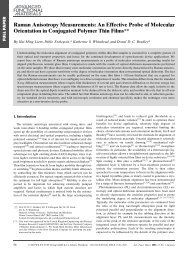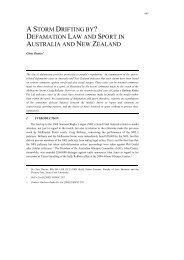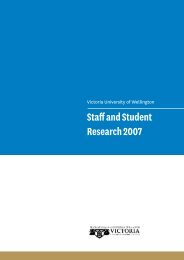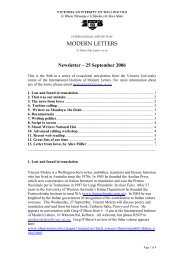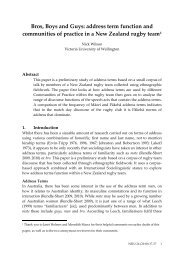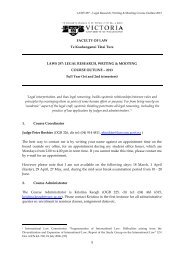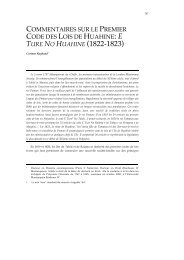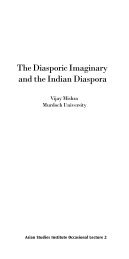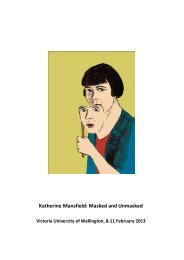Trimester 1 - Victoria University of Wellington
Trimester 1 - Victoria University of Wellington
Trimester 1 - Victoria University of Wellington
You also want an ePaper? Increase the reach of your titles
YUMPU automatically turns print PDFs into web optimized ePapers that Google loves.
2012<br />
<strong>Trimester</strong> 1 COURSE OUTLINE<br />
INTA251<br />
HISTORY OF INTERIOR ARCHITECTURE<br />
GENERAL<br />
Core; <strong>Trimester</strong> One; 15 points<br />
ASSESSMENT<br />
100% internal by assignment<br />
CLASSTIMES AND LOCATIONS<br />
LECTURES/SEMINAR: Tuesday 13.40-15.30 Room: VS318<br />
Friday 13.40-14.30 Room: VS318<br />
Please note: Class time may vary for site visits to take into account transport/venue availability, but this is likely to be<br />
a small variation (e.g. 15-30min).<br />
COORDINATOR<br />
Coordinator<br />
Name: Christine McCarthy<br />
Room: VS311<br />
Phone: 463-6164<br />
Office Hours: by appointment<br />
Email: christine.mccarthy@vuw.ac.nz<br />
Tutor<br />
Name: Mijntje Lepoutre<br />
Room: Architectural tutors room WG<br />
Office Hours: to be confirmed<br />
COURSE SYNOPSIS<br />
History courses in design education have interesting lineages. Interior architecture, for example, has historically<br />
followed the example set by Anglo-American architecture schools, which were established at the time when architects<br />
were creating themselves as a pr<strong>of</strong>ession in the mid-late nineteenth-century. This timing co-incided with the<br />
Freemasons' attempts to construct their historical origins in the medieval master masonry. They consequently spent<br />
much political time and energy in researching architectural and building history and established the first architectural<br />
history course at the <strong>University</strong> <strong>of</strong> London in the mid-nineteenth-century. Sir Banister Fletcher - a renown architectural<br />
1
historian and author <strong>of</strong> A History <strong>of</strong> Architecture on the Comparative Method for students, craftsmen and amateurs<br />
(1896) - was also a well known Freemason. Architectural history hence became an important part <strong>of</strong> the eosteric<br />
knowledge which distinguished architects as pr<strong>of</strong>essionals from craftsmen, that is to say, in order to contribute to the<br />
developing identity <strong>of</strong> the pr<strong>of</strong>ession or discipline.<br />
The teaching <strong>of</strong> history in interior design programmes in polytechnics and later in universities continued this tradition,<br />
in part to also suggest the interior design pr<strong>of</strong>ession had a status higher than decorators. This history course is aware<br />
<strong>of</strong> its obligation to also contribute to the changing identity <strong>of</strong> our discipline <strong>of</strong> interior architecture, but it will also<br />
consider what the knowledge and understanding <strong>of</strong> interior architectural history can also give to the practice <strong>of</strong> interior<br />
architectural design.<br />
In addition, the course reinforces learning outcomes <strong>of</strong> SARC151, specifically: essay writing skills (including<br />
referencing), knowledge <strong>of</strong> design history, the development <strong>of</strong> an argument with reference to relevant design<br />
examples and library skills. It also draws on drawing skills learnt in SARC111, SARC112 as tools to complement<br />
written analysis.<br />
Achieving well in the course will be assisted by the following:<br />
- attending all classes, tutorials, crits and site visits<br />
- engaging in group and independent research outside class<br />
- participating in class discussion<br />
- and submitting all assignment work<br />
If students are not clear what is required <strong>of</strong> them they should contact the course co-ordinator. Documented feedback<br />
and assessment will follow each hand-in.<br />
AIMS OF THE COURSE<br />
The aim <strong>of</strong> the course is for you to develop an understanding <strong>of</strong> interior architecture histories within the context <strong>of</strong> a<br />
pr<strong>of</strong>essional design degree. This will require a broad knowledge <strong>of</strong> the histories <strong>of</strong> interior architecture and indepth<br />
knowledge <strong>of</strong> specific examples <strong>of</strong> interior architecture (both domestic and public interior architecture). It will also<br />
require demonstrated knowledge and ability in the use <strong>of</strong> libraries and archives and in library finding aids (e.g.<br />
catalogues and periodical indexes). The course will also examine how interior architecture is represented in historical<br />
accounts and how representation enables connections between historic and contemporary design practice.<br />
COURSE LEARNING OBJECTIVES<br />
1) Knowledge<br />
Students who pass this course will understand:<br />
- historical knowledge <strong>of</strong> interior architecture<br />
- the relationships between broader developments in history and developments in interior architecture<br />
- a discipline-specific understanding <strong>of</strong> how history is made and represented<br />
- the importance <strong>of</strong> local interior architectural history and heritage<br />
- how to access source material for research in interior architecture, ie journals, oral histories, film, articles by<br />
historians, drawings, archives, site visits, etc.<br />
- the uses, impacts, differences, similarities, advantages and disadvantages <strong>of</strong> source materials for historical<br />
research<br />
2) Creative & Critical Thinking<br />
Students who pass this course will have learnt to:<br />
- use (written and non-written) design media in historical research and analysis<br />
- apply critical knowledge <strong>of</strong> history to the design <strong>of</strong> interior architecture<br />
3) Communication<br />
Students who pass this course will have learnt to:<br />
- consolidate skills in essay writing, specifically articulating an argument with reference to relevant examples from<br />
interior architectural history<br />
- formulate and advance an interior architecture perspective in writing<br />
- use non-written media as an analytical medium<br />
2
GRADUATE SKILLS<br />
Graduate Skills<br />
Knowledge<br />
Information literacy <br />
Creative and Critical Thinking<br />
Problem solving<br />
Critical evaluation <br />
Work autonomously <br />
Creativity and innovation <br />
Communication<br />
Effective communication (written) <br />
Effective communication (oral) <br />
Effective communication (graphic) <br />
Work effectively in a team setting <br />
Leadership<br />
Ethical behaviour in social / pr<strong>of</strong>essional / work environments<br />
Understanding <strong>of</strong> the Treaty <strong>of</strong> Waitangi <br />
COURSE CONTENT<br />
The course presents specific knowledge about the history <strong>of</strong> public and private interior architecture (e.g. Domestic<br />
Interiors, Retail/Commerical Interiors, Office/Corporate Interiors, Ecclesiastical Interiors, Government Interiors, Prison<br />
Interiors, Cinema Interiors, Library Interiors) as well as requiring students to consider how history itself is produced,<br />
constructed and represented.<br />
COURSE DELIVERY<br />
The course will use a combination <strong>of</strong> lectures, workshop/seminars, studio teaching and site visits. Some material will<br />
also be made available on Blackboard.<br />
ASSIGNMENTS/PROJECTS<br />
The course will be assessed by three pieces <strong>of</strong> assessment (2 experiments and 1 test) as follows:<br />
EXPERIMENT 1 (35%) Domestic Interiors (submission Tuesday, 27nd March,1.40pm in class)<br />
Learning Objectives:<br />
- to understand how history is made<br />
- to demonstrate knowledge <strong>of</strong> the NZ domestic interior as provided through specified sources<br />
Handin requirements:<br />
- 1x 1000 words essay formatted as prescribed below in Assessment Requirements<br />
The first experiment requires you to find the uses, impacts, differences, similarities (advantages and disadvantages) <strong>of</strong><br />
a specific source for historical research.<br />
The class will be divided into 9 groups <strong>of</strong> 5 or 6 students. Each group will examine three examples <strong>of</strong> source material<br />
from three time periods and consider:<br />
- the type <strong>of</strong> information about NZ domestic interiors (both Maori and Pakeha)<br />
- how information is presented<br />
- what is not presented<br />
- the type <strong>of</strong> history which will be produced if only this source material is used<br />
- the advantages and disadvantages <strong>of</strong> this source material<br />
- how the domestic interior is represented<br />
3<br />
Taught<br />
Practised<br />
Assesse<br />
d
Consider what you can learn about: décor, number and shape <strong>of</strong> rooms, the relationships between rooms, the<br />
relationship between inside and outside, domestic technology (e.g. kitchen appliances), the number and type <strong>of</strong><br />
people (e.g. class, gender, culture etc.) living in the house, lifestyle and habitation etc. from these sources.<br />
You are welcome to work together as a group where it seems sensible, but each student will need to submit individual<br />
essays/reports, and will be marked separately.<br />
GROUP 1: Newspapers/Magazines<br />
You will examine three New Zealand newspapers (one from each <strong>of</strong> the three time periods).<br />
1990s The Evening Post (20 April 1999), New Zealand Collection, <strong>Wellington</strong><br />
Public Library<br />
1960s Te Ao Hou: The New World 47 (June 1964), Alexander Turnbull Library<br />
(http://teaohou.natlib.govt.nz/teaohou/index.html)<br />
1880s Taranaki Herald (9 January 1883) Alexander Turnbull Library,<br />
http://paperspast.natlib.govt.nz/cgi-bin/paperspast<br />
GROUP 2: Oral history<br />
You will interview a person from each time period and ask them about the New Zealand (if possible) house they<br />
lived in when they were at primary school. The person you interview must be a classmate, a family member or<br />
a friend, and be aware that you are interviewing them for a university assignment.<br />
1985-2000 one <strong>of</strong> the other students in your group<br />
1960-1975 one <strong>of</strong> your parents or another person <strong>of</strong> a similar age<br />
1920-1945 one <strong>of</strong> your grandparents or another person <strong>of</strong> a similar age<br />
GROUP 3: Film<br />
You will examine three New Zealand films/music videos as listed (one from each <strong>of</strong> the three time periods).<br />
1960s-1970s The Making Of Domestic Warfare dir. Alexis Hunter. New Zealand,<br />
undated. <strong>Wellington</strong> Film Archive 1999.2472 OR<br />
[Aberhart's House] dir Joanna Paul. New Zealand, 1976. <strong>Wellington</strong> Film<br />
Archive 2003.9456<br />
1935-1950 The Pro<strong>of</strong> <strong>of</strong> the Pastry Pacific Film Unit. New Zealand, 1948. <strong>Wellington</strong><br />
Film Archive 1995.3603 OR<br />
Housing in New Zealand (New Zealand National Film Unit. New Zealand,<br />
1900s/<br />
1862,1873,2010<br />
1946. Architecture and Design Library Vis 3733<br />
"Olveston" Pictorial Parade 210 New Zealand National Film Unit. New<br />
Zealand, 1969. <strong>Wellington</strong> Film Archive 1995.1984 OR Hanna Grace "Red<br />
Lips" (2010) http://www.youtube.com/watch?v=BJcw13xz0_8 (Highwic,<br />
Epsom, Auckland, 1862, 1873)<br />
GROUP 4: Architectural Drawings<br />
You will examine three architectural drawings as listed (one from each <strong>of</strong> the three time periods).<br />
1980s Michael Fowler "The Favourite Brick Paved Courtyard Proposal" Vavasour<br />
Farmhouse, Blenheim, 1982, Gray Young Collection 45a, Architecture<br />
and Design Library light table display.<br />
1940s Demonstration House, 17 Makara Rd, Karori, Architectural Centre (WWC<br />
Archives, Barker St: please visit as a group, ring first to organise a time<br />
(801-2096 - will need 24hrs notice at least), and bring your student ID,<br />
cost is $5 plus copying. The Archive's hours are: 9am - 4pm Mon – Fri,)<br />
1920s Richardson Residence, 1921, W. Gray Young R1, Architecture and<br />
Design Library light table display.<br />
GROUP 5: Articles by Historians<br />
You will examine three articles as listed (which each discuss one <strong>of</strong> the time periods).<br />
4
1960s lloyd-Jenkins, Douglas "To Live One’s Life in Full View: John Greer and<br />
the Greer House" Formulation Fabrication: The Architecture <strong>of</strong> History:<br />
Proceedings <strong>of</strong> the seventeenth annual conference <strong>of</strong> the Society <strong>of</strong><br />
Architectural Historians, Australia and New Zealand: <strong>Wellington</strong>, New<br />
Zealand, November 2000 <strong>Wellington</strong>: SAHANZ, 2000. 251-258.<br />
Architecture and Design Library Big books NA1600 S678 2000 F<br />
1940s Gatley, Julia "Contemporary Dwelling: the Demonstration House" Zeal and<br />
Crusade Christchurch: Te Waihora Press, c1996. 88-102. Architecture<br />
and Design Library NA1607 W452 Z41<br />
1860s Petersen, Anna "The European Use <strong>of</strong> Maori Art in New Zealand Homes<br />
c1890-1914" At Home in New Zealand: Houses History People ed Barbara<br />
Brookes (<strong>Wellington</strong>: Bridget Williams Books, 2000) pp. 57-72. [focus on<br />
Rehutai] Architecture and Design Library HQ722.5 A861<br />
GROUP 6: Pr<strong>of</strong>essional design journals<br />
You will examine three articles as listed (one from each <strong>of</strong> the three time periods).<br />
2000s Walsh, John "Farmhouse to Arthouse" Architecture New Zealand 4 (July-<br />
August 2002): 80-86. Architecture and Design Library periodicals NA1 N<br />
1950s "A Contemporary House in an Old Garden" Home and Building (1 July<br />
1953): 26-29, 43. Architecture and Design Library periodicals NA1 H675<br />
1940s Wilson, Bill "The Small House" (1948) New Dreamland ed. Douglas Lloyd<br />
Jenkins. Auckland: Godwit, 2006. 146-153. Architecture and Design<br />
Library Closed Reserve NA1606 N532<br />
GROUP 7: Archives (Photographic, Perspective Drawings)<br />
You will examine three archival artefacts as listed (one from each <strong>of</strong> the three time periods).<br />
1960s View <strong>of</strong> the living room, Alington House,Winder Duncan, 1919-1970, Alexander<br />
Turnbull Library, PA-Group-00395 Ref DW-4206-F.<br />
(http://find.natlib.govt.nz/primo_library/libweb/action/dlDisplay.do?dscnt=0&vid=TF&dstmp=132881<br />
9801422&docId=nlnz_tapuhi875429&fromLogin=true)<br />
1930s Interior <strong>of</strong> Art Deco house, photographed by K E Niven and Co <strong>of</strong> <strong>Wellington</strong>, Timeframes,<br />
Alexander Turnbull Library, ID: 1/2-209042-F. At the following webpage use the ID number in the<br />
search box to find the image http://find.natlib.govt.nz/primo_library/libweb/action/search.do?vid=TF<br />
1880s House interior, photographed circa 1880s, by William Williams. Timeframes, Alexander Turnbull<br />
Library, ID:1/2-140288-G. At the following webpage use the ID number in the search box to find the<br />
image http://find.natlib.govt.nz/primo_library/libweb/action/search.do?vid=TF<br />
GROUP 8: Houses<br />
You will examine three houses as listed (one from each <strong>of</strong> the three time periods).<br />
2000s your family home, your flat, or a friend's home<br />
1900s Antrim House, 63 Boulcott St (contact:Aimee ph: 494-8281 or reception<br />
ph: 472-4341 to organise a time)<br />
1850s Colonial Cottage Museum, 68 Nairn St (contact: Beverley 384 9122; hours<br />
12.00- 3.00pm everyday until 18 March 2012 (after 18 March weekends);<br />
or group bookings Tues-Thursday see<br />
http://www.colonialcottagemuseum.co.nz/colonial-cottage-museum/cost<br />
$8 each)<br />
GROUP 9: Websites<br />
You will examine three websites about houses as listed (one from each <strong>of</strong> the three time periods).<br />
Source<br />
2000s Open2View (http://www.nz.open2view.com/)<br />
1920s New Zealand Historic Places Trust: Pouhere Taonga: Truby King House (Former)<br />
5
(http://www.historic.org.nz/TheRegister/RegisterSearch/RegisterResults.aspx?RID=4427)<br />
1870s Highwic (http://www.historicplaces.org.nz/placesToVisit/auckland/Highwic.aspx)<br />
Assessment Criteria:<br />
Your essays will be assessed as follows:<br />
- that you have demonstrated careful analysis <strong>of</strong> the specified source for each time period<br />
- that you have demonstrated an understanding <strong>of</strong> what issues would impact on histories made from the<br />
specified sources you are examining<br />
- that you have demonstrated intelligent discussion <strong>of</strong> the relevant issues illustrated with examples from<br />
your research<br />
- that you have good essay writing skills<br />
EXPERIMENT 2 (50%) Public Interiors (submission Friday, 25th May, 1.40pm in class)<br />
Learning Objectives:<br />
- to understand the historical context <strong>of</strong> the selected design<br />
- to demonstrate specific knowledge <strong>of</strong> the chosen domestic interior.<br />
- to undertake bibliographic and periodical searching <strong>of</strong> a high level.<br />
- to understand the impact <strong>of</strong> representation on the specific history <strong>of</strong> the chosen interior design<br />
- to use design media (writing and drawing) in historical research and analysis<br />
Handin requirements:<br />
- 1x 2000 words typed essay formatted as prescribed above in Assessment Requirements<br />
- a series <strong>of</strong> 4 drawings (each drawing to be 110mmx170mm)<br />
The second experiment requires you to analyse an historic public interior.<br />
Select an historic public interior which is represented in film media (one scene or part <strong>of</strong> one scene). Research the<br />
broad historical and cultural context <strong>of</strong> the interior as well as the specific interior (construction, plan, location within the<br />
building, furnishings etc.). Use both writing and drawing to analyse the relationship between conventional historical<br />
understandings <strong>of</strong> the interior and how the interior is represented.<br />
Essays and drawings should demonstrate knowledge <strong>of</strong> the historical interiors created. Discuss the historical<br />
accuracy <strong>of</strong> the interior. Historical inaccuracies should be considered in their role in the film rather than simply<br />
aberrations. Discuss how the interior is used to progress the film, and give possible reasons for any inaccuracies.<br />
The analysis will consider the historical context <strong>of</strong> the interior, at the time the film is set, and its representation. How<br />
are specific filmic techniques used to present and comment on the interior? Refer to specific details and formal<br />
qualities <strong>of</strong> the image (e.g. colour, black and white, visual clarity or obscurity <strong>of</strong> line/focus, light, contrast, framing,<br />
compositional subject, movement, viewpoint etc). The analysis will use drawing and writing to examine the relevant<br />
historigraphical and historical issues in the chosen filmic interior. A list <strong>of</strong> films will be supplied.<br />
The series <strong>of</strong> four drawings will analyse ideas <strong>of</strong> composition, framing, lighting, movement, etc present in the<br />
depiction <strong>of</strong> the historic interior. The exact dimensions <strong>of</strong> the drawings are to be 110mm x 170mm. The drawings<br />
should carefully interpret how the historic interior is represented, and should critically exploit the given dimensions.<br />
Drawings will be able to be displayed successfully from any orientation.<br />
Choose from ONE <strong>of</strong> the following public interiors: Cinema interiors, Ecclesiastical interiors, Government interiors,<br />
Library interiors, Office/Corporate interiors, Prison interiors, Railway interiors, Retail/Commerical interiors. Pleasure<br />
and enjoyment should be the principles upon which the selection <strong>of</strong> the historic public interior is made. Engagement<br />
with theoretical ideas is vital, though it will not quash issues <strong>of</strong> aesthetic sensuality in your writing and drawing.<br />
Assessment Criteria:<br />
The written and drawn texts that you make need to demonstrate intimacies which can only be produced by close<br />
reading and the input <strong>of</strong> time. They need to negotiate a number <strong>of</strong> requirements which will be assessed:<br />
- that you have demonstrated that you are well informed about the specific history <strong>of</strong> the interior which is<br />
represented<br />
- that you have demonstrated that you are well informed about the more general historical context <strong>of</strong> the design<br />
represented<br />
- that you have demonstrated an understanding <strong>of</strong> representation on the design history <strong>of</strong> this interior<br />
- that you have demonstrated bibliographic and periodical searching <strong>of</strong> a high level.<br />
- that you have good essay writing and drawing skills<br />
6
TEST (15%) via Blackboard (Friday 8th June)<br />
Learning Objectives:<br />
- to demonstrate factual knowledge <strong>of</strong> interior architectural history<br />
Requirement:<br />
The test will require students answer 50 questions randomly selected from a pool <strong>of</strong> 300 questions generated by<br />
lecture content. Students can practice the test as many times as they like from 1st May until the Test, which will be<br />
held in class on 8 June.<br />
n.b. If you are having problems taking the test from a non-university computer you may need to use a computer in one<br />
<strong>of</strong> the labs at the School <strong>of</strong> Architecture.<br />
Assessment Criteria:<br />
The test will be assessed as follows:<br />
- demonstration <strong>of</strong> factual knowledge<br />
ASSESSMENT SUMMARY<br />
INTA251 is internally assessed by assignment work in the form <strong>of</strong> three experiments and one test. Assignments are<br />
assessed and graded A+, A, A-, B+, B, B-, C+, C, D, E, (where C is a PASS). Grades only are issued to students. The<br />
final grade for the course is based on the aggregation <strong>of</strong> the percentage marks for each <strong>of</strong> the assignments, and a<br />
final grade <strong>of</strong> C or better is required to pass the course. The three experiments and one test contribute towards the<br />
final course grade as follows:<br />
Experiment 1 "Domestic Interiors" (3 weeks) due 27 March ........ 35%<br />
Experiment 2 "Public Interiors" (7 weeks) due 25 May ................ 50%<br />
Test: 8 June .............................................................................. 15%<br />
Total: ...................................................................................... 100%<br />
ASSESSMENT REQUIREMENTS<br />
All written essays must have the student's name on the top right-hand corner <strong>of</strong> the front page and a right margin <strong>of</strong><br />
at least 3cm on all pages (as per the Essay front page example in Appendix B). A reference list is required. Attach<br />
pages using a staple in the top left hand corner. Please do not submit your work in a plastic folder, or in plastic<br />
sleeves. All written submissions must be referenced and include reference lists and footnotes. See Guide to<br />
Referencing (Appendix C)<br />
The School has a long tradition <strong>of</strong> providing critical review <strong>of</strong> student work as it progresses especially in design<br />
projects. This is part <strong>of</strong> feed-back for learning purposes. Such reviews must not be misunderstood as indicators<br />
<strong>of</strong> standards and they are different from assessment. Students have a responsibility to attend critical reviews at<br />
the appointed time as part <strong>of</strong> the learning process. Review panels are <strong>of</strong>ten composed <strong>of</strong> internal and external<br />
members for the appointed times and cannot be re-composed to consider late submissions. Consequently late<br />
work will not receive a critical review, though it will be assessed subject to any penalties as set out below.<br />
Critical Review: May take place during the development phases <strong>of</strong> a project as well as at the time <strong>of</strong> the final<br />
submission. Its purpose is to identify strengths and weaknesses in the work and to <strong>of</strong>fer suggestions to<br />
generally encourage the student. An encouraging critical review does not necessarily mean a good assessment<br />
result.<br />
Assessment: May take place at a stage in a project or on final submission (or both). Its purpose is to value the<br />
work in terms <strong>of</strong> the objectives stated in the handout and to express this as a grade. Moderation <strong>of</strong> all<br />
assessment in design is undertaken at the end <strong>of</strong> the <strong>Trimester</strong> after critical reviews, involving a wider group <strong>of</strong><br />
staff than the immediate lecturers in the course. This process ensures fairness.<br />
All work submitted for assessment must be accompanied by an ASSESSMENT DECLARATION FORM.<br />
All grades posted during this course are only provisional results until confirmed by the School Examiners Committee<br />
which meets after the examination period.<br />
PENALTIES<br />
For work that arrives late, the following penalty will be applied for the School <strong>of</strong> Architecture: 5% immediately, then 5%<br />
for every subsequent 24 hours including weekends.<br />
7
Absence from class is penalised at 1% per class absent.<br />
ATTENDANCE AND PARTICIPATION<br />
Attendance and participation is an important aspect <strong>of</strong> the learning process, and you are required to attend all the<br />
lectures and tutorials.<br />
If extraordinary circumstances arises that require you to be absent from some class sessions, you should discuss the<br />
situation with the Course Coordinator as soon as possible.<br />
COURSE EXPECTED WORKLOAD<br />
As a 15 point course you should expect to spend approx 150 hours on ITDN251 (i.e. 10 hours per point)<br />
- 3 hours scheduled class time per week for 12 teaching weeks<br />
- Approx 8 hours per week <strong>of</strong> individual unsupervised work for 12 teaching weeks<br />
- Approx 18 hours additional work during the mid trimester break, study break and examination period<br />
http://www.victoria.ac.nz/home/about_victoria/avcacademic/publications/assessment-handbook.pdf<br />
MATERIALS AND EQUIPMENT REQUIRED<br />
Materials and equipment required will vary depending on how students respond to each experiment brief. It is the student's<br />
responsibility to meet these material and equipment expenses, though it is envisaged that the equipment available in the<br />
school's computer laboratories, studios and workshop should be adequate for most equipment needs. Computer facilities<br />
are available at the School, and the library has good work processing facilities. If you are purchasing a laptop and would<br />
like information on the minimum requirements please contact the Student Administration Office. Note: The Student Loan,<br />
administered by StudyLink, allows students to claim up to $1000 for course related costs for each year <strong>of</strong> study. If you are<br />
purchasing a laptop and would like information on the minimum requirements please contact the Student Administration<br />
Office. While digital cameras are available at the school, it is also recommended that students consider purchasing a<br />
simple digital camera (3.2mpxl minimum). Note: The Student Loan, administered by StudyLink, allows students to claim up<br />
to $1000 for course related costs for each year <strong>of</strong> study.<br />
SUBMISSION OF WORK<br />
Each student is responsible for ensuring their work is submitted on time and in the required format.<br />
Late submissions will be penalised as set out above, unless an extension is approved by the Course Coordinator.<br />
EXTENSIONS<br />
In the event <strong>of</strong> illness or other extraordinary circumstances that prevent you from submitting a piece <strong>of</strong> work on time,<br />
or that you feel adversely affect the quality <strong>of</strong> the work you submit, it is important that you discuss your circumstances<br />
with the Course Coordinator as soon as possible so that appropriate arrangements may be made. You should<br />
complete an Application for Extension form (available from the Faculty Office) for the Course Coordinator to approve.<br />
You will also need to provide suitable evidence <strong>of</strong> your illness or other circumstances. In an emergency, or if you are<br />
unable to contact the Course Coordinator, you should advise the Faculty Office <strong>of</strong> your situation.<br />
Failure to backup your assignment work on your computer is not grounds for an extension.<br />
MANDATORY COURSE REQUIREMENTS<br />
None<br />
COMMUNICATION OF ADDITIONAL INFORMATION<br />
The course is set up on Blackboard. Any changes or additions to this Course Outline will be discussed and agreed<br />
with the class, and conveyed through Blackboard to all students enrolled in the course.<br />
8
APPENDIX A: Readings and Reference material<br />
The following books are being held on 3-Day Loan for this course:<br />
Ashford, Jeremy The bungalow in New Zealand Auckland, N.Z.: Viking, 1994. [Architecture & Design Library<br />
NA7572.5 N5 A825 B]<br />
Cerver, Francisco Asensio The Architecture <strong>of</strong> Stations and Terminals New York: Arco, Hearst Books<br />
International, 1997. [Architecture & Design Library - big book NA6290 A816 S]<br />
Cottrell, William Furniture <strong>of</strong> the New Zealand colonial era: an illustrated history, 1830-1900 Auckland, N.Z.:<br />
Reed, 2006. [Architecture & Design Library NK2692 A1 C851 F]<br />
Darley, Gillian Factory London: Reaktion, 2003. [Architecture & Design Library NA6400 D221 F]<br />
Evans, Robin The fabrication <strong>of</strong> virtue: English prison architecture, 1750-1840 Cambridge [Cambridgeshire];<br />
New York : Cambridge <strong>University</strong> Press, 1982. [Architecture & Design Library HV8829 G72 E5 E92 F]<br />
Field, Audrey Picture Palace: A Social History <strong>of</strong> the Cinema London: Century Books, 1974. [Architecture &<br />
Design Library PN 1993.5 G7 F453 P]<br />
Johnston, Norman Bruce Forms <strong>of</strong> constraint: a history <strong>of</strong> prison architecture Urbana; Chicago: <strong>University</strong> <strong>of</strong><br />
Illinois Press, c2000. [Architecture & Design Library - big book HV8805 J73 F]<br />
Martin, Reinhold The organizational complex: architecture, media, and corporate space Cambridge,<br />
Massachusetts: MIT Press, 2003. [Architecture & Design Library NA2543 S6 M382 O]<br />
Massey, Anne Interior design <strong>of</strong> the 20th century London: Thames & Hudson, 2001. [Architecture & Design<br />
Library NK1980 M416 I 2001]<br />
Morrison, Kathryn English Shops and Shopping: an architectural history New Haven: Yale <strong>University</strong> Press,<br />
2003. [Architecture & Design Library - big books NA6220 M879 E]<br />
Murray, David Museums, their history and their use London: Routledge/Thoemmes Press, 1996. [Architecture<br />
& Design Library AM5 M981 M]<br />
Neich, Roger Painted histories: early Maori figurative painting Auckland, N.Z.: Auckland <strong>University</strong> Press, 1994.<br />
[Architecture & Design Library N7406.5 N397 P]<br />
Norman, Edward The House <strong>of</strong> God: church architecture, style and history London: Thames and Hudson,<br />
1990. [Architecture & Design Library - big book NA4800 N842 H]<br />
On the job: design and the American <strong>of</strong>fice ed. Donald Albrecht and Chrysanthe B. Broikos, New York:<br />
Princeton Architectural Press, c2000. [Architecture & Design Library NK2195 O4 O58]<br />
Phillipps, W. J. (William John) Maori houses and food stores <strong>Wellington</strong>, N.Z.: Govt. Print., 1952. [Architecture<br />
& Design Library NA1606.5 P557 M4]<br />
Shaw, Peter A history <strong>of</strong> New Zealand architecture Auckland, N.Z.: Hodder Moa Beckett, 1997. [Architecture &<br />
Design Library - big book NA1606 S535 H]<br />
Stewart, Di The New Zealand villa: past and present Auckland, N.Z.: Viking Pacific, c1992. [Architecture &<br />
Design Library NA7472 S849 N]<br />
The following books are on Closed Reserve for this course:<br />
Abercrombie, Stanley A century <strong>of</strong> interior design, 1900-2000: a timetable <strong>of</strong> the design, the designers, the<br />
products, and the pr<strong>of</strong>ession New York: Rizzoli, 2003. [Architecture & Design Library NK1980 A144 C]<br />
Brown, Deidre Maori Architecture: from fale to wharenui and beyond Auckland, N.Z.: Raupo, 2009.<br />
[Architecture & Design Library NA1606.5 B877 M2 2009]<br />
Petersen, Anna K. C. New Zealanders at home: a cultural history <strong>of</strong> domestic interiors 1814-1914 Dunedin:<br />
<strong>University</strong> <strong>of</strong> Otago Press, 2001. [Architecture & Design Library - big book NK2093 P484 N]<br />
Salmond, Jeremy Old New Zealand Houses 1800-1940 Auckland [N.Z.]: Reed Methuen, 1986. [Architecture &<br />
Design Library NA7472 S172 O]<br />
Toomath, William Built in New Zealand: the houses we live in Auckland, N.Z.: HarperCollins, 1996.<br />
[Architecture & Design Library NA7472 T672 B]<br />
If you are having difficulty accessing any <strong>of</strong> these books, or you consider that other books should be placed on 3-day<br />
loan or on Closed Reserve please let the Course Co-ordinator know. It may take a couple <strong>of</strong> weeks to do this so<br />
advising the Course Co-ordinator earlier rather than later is encouraged.<br />
9
APPENDIX B: Essay Front Page Example<br />
staple at Student Name<br />
top left-hand INTA251<br />
corner Experiment No.<br />
Beautifully written and well referenced essay text. Beautifully written and well referenced essay<br />
text. Beautifully written and well referenced essay text. Beautifully written and well referenced<br />
essay text. Beautifully written and well referenced essay text. Beautifully written and well<br />
referenced essay text. Beautifully written and well referenced essay text. Beautifully written and<br />
well referenced essay text. Beautifully written and well referenced essay text. Beautifully written<br />
and well referenced essay text. Beautifully written and well referenced essay text. Beautifully<br />
written and well referenced essay text. Beautifully written and well referenced essay text.<br />
Beautifully written and well referenced essay text. Beautifully written and well referenced essay<br />
text. Beautifully written and well referenced essay text. Beautifully written and well referenced<br />
essay text. Beautifully written and well referenced essay text. Beautifully written and well<br />
referenced essay text. Beautifully written and well referenced essay text. Beautifully written and<br />
well referenced essay text. Beautifully written and well referenced essay text. Beautifully written<br />
and well referenced essay text. Beautifully written and well referenced essay text. Beautifully<br />
written and well referenced essay text. Beautifully written and well referenced essay text.<br />
Beautifully written and well referenced essay text. Beautifully written and well referenced essay<br />
text. Beautifully written and well referenced essay text. Beautifully written and well referenced<br />
essay text. Beautifully written and well referenced essay text. Beautifully written and well<br />
referenced essay text. Beautifully written and well referenced essay text. Beautifully written and<br />
well referenced essay text. Beautifully written and well referenced essay text. Beautifully written<br />
and well referenced essay text. Beautifully written and well referenced essay text. Beautifully<br />
written and well referenced essay text. Beautifully written and well referenced essay text.<br />
Beautifully written and well referenced essay text. Beautifully written and well referenced essay<br />
text. Beautifully written and well referenced essay text. Beautifully written and well referenced<br />
essay text. Beautifully written and well referenced essay text. Beautifully written and well<br />
referenced essay text. Beautifully written and well referenced essay text. Beautifully written and<br />
well referenced essay text. Beautifully written and well referenced essay text. Beautifully written<br />
and well referenced essay text. Beautifully written and well referenced essay text. Beautifully<br />
written and well referenced essay text. Beautifully written and well referenced essay text.<br />
Beautifully written and well referenced essay text. Beautifully written and well referenced essay<br />
text. Beautifully written and well referenced essay text. Beautifully written and well referenced<br />
essay text. Beautifully written and well referenced essay text. Beautifully written and well<br />
referenced essay text. Beautifully written and well referenced essay text. Beautifully written and<br />
well referenced essay text. Beautifully written and well referenced essay text. Beautifully written<br />
and well referenced essay text. Beautifully written and well referenced essay text. Beautifully<br />
written and well referenced essay text. Beautifully written and well referenced essay text.<br />
Beautifully written and well referenced essay text. Beautifully written and well referenced essay<br />
text. Beautifully written and well referenced essay text. Beautifully written and well referenced<br />
essay text. Beautifully written and well referenced essay text. Beautifully written and well<br />
referenced essay text. Beautifully written and well referenced essay text. Beautifully written and<br />
well referenced essay text. Beautifully written and well referenced essay text. Beautifully written<br />
and well referenced essay text. Beautifully written and well referenced essay text. Beautifully<br />
written and well referenced essay text. Beautifully written and well referenced essay text.<br />
Beautifully written and well referenced essay text. Beautifully written and well referenced essay<br />
text. Beautifully written and well referenced essay text. Beautifully written and well referenced<br />
essay text. Beautifully written and well referenced essay text. Beautifully written and well<br />
referenced essay text.<br />
page no.<br />
10
APPENDIX C: Guide to Referencing<br />
All written submissions must be referenced and include reference lists and footnotes.<br />
Reference Lists summarise the references which you have used in the text and only cite texts which have been<br />
quoted or explicitly refered to in your essay. Texts in the reference list are listed in alphabetical order. The full<br />
citation format to be used (for bibliographies) is as follows:<br />
Authored Books: Author/s Title Place <strong>of</strong> Publication: Publisher, Date.<br />
e.g. Stewart, Susan Crimes <strong>of</strong> Writing Durham and London: Duke <strong>University</strong> Press, 1994.<br />
Edited Books: Title Editor/s. Place <strong>of</strong> Publication: Publisher, Date.<br />
e.g. Cultures <strong>of</strong> Natural History Ed. N. Jardine, J. A. Secord and E. C. Spary. Cambridge: Cambridge <strong>University</strong> Press,<br />
1996.<br />
*please note that book citations in a bibliography will not have page numbers<br />
Periodical Articles: Author "Article title" Periodical Title volume, number, (Date), page/s.<br />
e.g. Freeman, James "Democracy and Danger on the Beach: Class Relations in the Public Space <strong>of</strong> Rio de Janeiro"<br />
Space and Culture 5.1 (February 2002): 9-28.<br />
Chapters in Edited Books: Author "Chapter title" Title Editor/s. Place <strong>of</strong> Publication: Publisher, Date. page/s.<br />
e.g. Spary, Emma "Political, natural and bodily economies" Cultures <strong>of</strong> Natural History Ed. N. Jardine, J. A. Secord<br />
and E. C. Spary. Cambridge: Cambridge <strong>University</strong> Press, 1996. 178-196.<br />
*please note that chapter citations in a bibliography will have page numbers <strong>of</strong> the entire article<br />
Films: Title Director. Country, date.<br />
e.g. The Cabinet <strong>of</strong> Dr. Caligari dir. Robet Weine. Germany, 1919.<br />
Webpages: Author "Article title" Website Title Date created. Website Author/Owner. Date accessd. url.<br />
Wiens, Janet "Success in the Details" Interiors and Sources January/February 2008. Stamats Business Media. 19<br />
February 2008 <br />
Footnotes are references which are marked in the text (usually a superscripted number) and relate to a specific part<br />
<strong>of</strong> the text (e.g. a quotation, a commentary made about some aspect <strong>of</strong> the main text). Footnotes reference the<br />
particular page refered to so relevant page numbers must be included in the reference. An abbreviated reference is<br />
sufficient for footnote references (e.g. Author surname page/s - i.e. Stewart 33.) The short citation format to be<br />
used (for footnotes) is as follows:<br />
Authored Books: Author/s page/s<br />
e.g. Stewart 34-35.<br />
Edited Books: Title page/s<br />
e.g. Cultures <strong>of</strong> Natural History 159.<br />
Periodical Articles: Author page/s.<br />
e.g. Freeman 16.<br />
Chapters in Edited Books: Author page/s.<br />
e.g. Spary 182.<br />
Films: Title unpaginated<br />
e.g. The Cabinet <strong>of</strong> Dr. Caligari unpaginated<br />
Webpages: Author unpaginated<br />
e.g. Tisch unpaginated<br />
n.b. if two (or more) references with the same author or the same title are discussed in the essay distinguish<br />
these in footnotes by including the date e.g. Stewart (1994) 34-35. and Cultures <strong>of</strong> Natural History (1996) 159.<br />
11
APPENDIX D: Institutions in <strong>Wellington</strong> for Historical Research<br />
NOTE<br />
Catalogues<br />
List <strong>of</strong> NZ libraries (and links to catalogues) is at:<br />
http://directory.natlib.govt.nz/library-symbols-web/<br />
Periodical Indexes<br />
VUW library list <strong>of</strong> periodical indexes are at:<br />
http://library.victoria.ac.nz/library/resources/online.html<br />
Useful Periodical Indexes: ARCH, Avery Index to Architectural Periodicals, Design and Applied Arts Index,<br />
Index New Zealand, Newsindex, Te Puna<br />
PUBLIC LIBRARIES<br />
Hutt City Libraries<br />
<strong>Wellington</strong> City Libraries: Te Matapihi ki te Ao Nui<br />
National Library <strong>of</strong> New Zealand: Te Puna Maatauranga o Aotearoa (note this library is largely closed during a<br />
two year refurbishment; a reading room at 77 Thorndon Quay, <strong>Wellington</strong> is available for access to some <strong>of</strong> the<br />
collection)<br />
Alexander Turnbull Library (access until mid 2012 will be limited as per the National Library)<br />
PARLIAMENTARY LIBRARY (library <strong>of</strong> last resort)<br />
MUSEUM LIBRARIES<br />
Te Aka Matua Te Papa Library and Information Centre (by appointment)<br />
UNIVERSITY LIBRARIES<br />
<strong>Victoria</strong> <strong>University</strong> (Architecture & Design, Kelburn Campus, Karori Campus, Law & Commerce Libraries)<br />
Massey <strong>University</strong><br />
NATIONAL ARCHIVES<br />
Te Aka Matua Te Papa Library and Information Centre<br />
Alexander Turnbull Library<br />
Archives New Zealand<br />
LOCAL ARCHIVES<br />
<strong>Wellington</strong> City Council Archives<br />
UNIVERSITY ARCHIVES<br />
The Beaglehole Room (Kelburn campus, Level 1, Library)<br />
Architecture and Design Archives Collection<br />
OTHER MEDIA<br />
Sound Archives/Nga Taonga Korero, Christchurch, http://www.soundarchives.co.nz/<br />
Film Archives, http://www.filmarchive.org.nz<br />
Television Archives, Lower Hutt, http://www.nztvarchive.co.nz/<br />
consider the environment before printing this document. If printing is required please set print<br />
properties to "black & white" and "2 sided print."<br />
12
SCHEDULE OF SESSIONS & ASSESSMENTS<br />
(there may be slight changes due to organising site visits)<br />
Week<br />
month<br />
Week 9<br />
February<br />
March<br />
Week 10<br />
March<br />
Week 11<br />
March<br />
Week 12<br />
March<br />
Week 13<br />
March<br />
Week 14<br />
April<br />
Week 15<br />
April<br />
Week 16<br />
April<br />
Week 17<br />
April<br />
Week 18<br />
April<br />
May<br />
Class Times & Location Tuesday 13.40-15.30 Room: VS318<br />
Friday 13.40-14.30 Room: VS318<br />
day<br />
date<br />
item<br />
M 27<br />
TU 28<br />
W 29 Orientation Week<br />
TH 1<br />
F 2<br />
M 5 <strong>Trimester</strong> 1 Begins<br />
TU 6 Course Introduction/Exp I introduction<br />
Interior Architecture, History & Representation I<br />
W 7<br />
TH 8<br />
F 9 Interior Architecture, History & Representation II<br />
M 12<br />
TU 13 Site Visit: WCC Archive/Referencing tutorial<br />
W 14<br />
TH 15<br />
F 16 Tutorial (house plans) Last day to withdraw (with fees<br />
refund)<br />
M 19<br />
TU 20 Site Visit: Film Archive<br />
W 21<br />
TH 22<br />
F 23 Domestic Interiors I (overview)<br />
M 26<br />
TU 27 Domestic Interiors II /Exp II introduction Exp 1 (35%) due<br />
W 28<br />
TH 29<br />
F 30 Ecclesiastical Interiors I (33 AD-mid C19th)<br />
M 2<br />
TU 3 Ecclesiastical Interiors I (mid C19th-C20th)/ tutorial (style)<br />
W 4<br />
TH 5<br />
F 6 Good Friday - holiday<br />
M 9 Easter Monday - holiday<br />
TU 10 Easter Tuesday – VUW holiday<br />
W 11<br />
TH 12<br />
F 13<br />
M 16 Mid <strong>Trimester</strong> Break<br />
TU 17<br />
W 18<br />
TH 19<br />
F 20<br />
M 23<br />
TU 24 Library interiors (700 BCE-C20th) / Retail/Commerical interiors (6<br />
BCE-C20th)<br />
W 25 ANZAC Day - holiday<br />
TH 26<br />
F 27 Government interiors (C7th AD-C20th)<br />
M 30<br />
TU 1 Site Visit: Parliament<br />
W 2<br />
TH 3<br />
F 4 tutorial<br />
13<br />
comments
Week 19<br />
May<br />
Week 20<br />
May<br />
Week 21<br />
May<br />
Week 22<br />
May<br />
June<br />
Week 23<br />
June<br />
Week 24<br />
June<br />
Week 25<br />
June<br />
Week 26<br />
June<br />
Week 27<br />
July<br />
Week 28<br />
July<br />
M 7<br />
TU 8 Prison interiors (C18th-C20th) /Railway interiors (eC19th-C20th)<br />
W 9<br />
TH 10<br />
F 11 Experiment II Interim Crit<br />
M 14<br />
TU 15 Site Visit<br />
W 16<br />
TH 17<br />
F 18 Factory interiors (C19th-C20th)<br />
M 21<br />
TU 22 Office/Corporate interiors (C19th-C20th)<br />
W 23<br />
TH 24<br />
F 25 Experiment II crit Exp 2 (50%) due<br />
M 28<br />
TU 29 Cinematic interiors (C20th)<br />
W 30<br />
TH 31<br />
F 1 Test Revision<br />
M 4 Queen’s Birthday - holiday<br />
TU 5 Test Revision<br />
W 6<br />
TH 7<br />
F 8 Test Test (15%)<br />
M 11 Study/Examination Period<br />
TU 12<br />
W 13<br />
TH 14<br />
F 15<br />
M 18<br />
TU 19<br />
W 20<br />
TH 21<br />
F 22<br />
M 25<br />
TU 26<br />
W 27<br />
TH 28<br />
F 29<br />
M 2<br />
TU 3<br />
W 4 Examination Period ends<br />
TH 5 Mid-year Break begins<br />
F 6<br />
M 9<br />
TU 10<br />
W 11<br />
TH 12<br />
F 13<br />
14
CLASS REPRESENTATIVES<br />
The Faculty <strong>of</strong> Architecture and Design operates a system <strong>of</strong> Class Representatives in 100-level courses,<br />
and Year Representatives in each <strong>of</strong> the pr<strong>of</strong>essional disciplines. Student Representatives are elected<br />
during a class session in the first week <strong>of</strong> teaching. All Student Representatives will be listed on the<br />
STUDiO notice board in the Atrium, and the relevant Representatives are also listed on studio notice<br />
boards. Student Representatives have a role in liaising between staff and students to represent the<br />
interests <strong>of</strong> students to the academic staff, and also in providing students with a communication channel to<br />
STUDiO and the Student Representation organiser.<br />
ACADEMIC INTEGRITY AND PLAGIARISM<br />
Academic integrity means that <strong>University</strong> staff and students, in their teaching and learning are expected to<br />
treat others honestly, fairly and with respect at all times. It is not acceptable to mistreat academic,<br />
intellectual or creative work that has been done by other people by representing it as your own original<br />
work.<br />
Academic integrity is important because it is the core value on which the <strong>University</strong>’s learning, teaching and<br />
research activities are based. <strong>Victoria</strong> <strong>University</strong>’s reputation for academic integrity adds value to your<br />
qualification.<br />
The <strong>University</strong> defines plagiarism as presenting someone else’s work as if it were your own, whether you<br />
mean to or not. ‘Someone else’s work’ means anything that is not your own idea. Even if it is presented in<br />
your own style, you must acknowledge your sources fully and appropriately. This includes:<br />
Material from books, journals or any other printed source<br />
The work <strong>of</strong> other students or students or staff<br />
Information from the internet<br />
S<strong>of</strong>tware programs and other electronic material<br />
Designs and ideas<br />
The organisation or structuring <strong>of</strong> any such material<br />
Find out more about plagiarism, how to avoid it and penalties, on the <strong>University</strong>’s website:<br />
www.victoria.ac.nz/home/studying/plagiarism.html<br />
USE OF TURNITIN<br />
Student work provided for assessment in this course may be checked for academic integrity by the<br />
electronic search engine http://www.turnitin.com. Turnitin is an online plagiarism prevention tool which<br />
compares submitted work with a very large database <strong>of</strong> existing material. At the discretion <strong>of</strong> the Head <strong>of</strong><br />
School, handwritten work may be copy-typed by the School and subject to checking by Turnitin. Turnitin will<br />
retain a copy <strong>of</strong> submitted material on behalf <strong>of</strong> the <strong>University</strong> for detection <strong>of</strong> future plagiarism, but access<br />
to the full text <strong>of</strong> submissions is not made available to any other party.<br />
15
GENERAL UNIVERSITY POLICIES & STATUTES – WHERE TO FIND MORE DETAILED<br />
INFORMATION<br />
Students should familiarise themselves with the <strong>University</strong>’s policies and statutes, particularly the<br />
Assessment Statute, the Personal Courses <strong>of</strong> Study Statute, the Statute on Student Conduct and any<br />
statutes relating to the particular qualifications being studied; see the <strong>Victoria</strong> <strong>University</strong> Calendar or the<br />
<strong>University</strong>’s policy website http://www.victoria.ac.nz/home/about/policy<br />
Student and staff conduct<br />
The Statute on Student Conduct together with the Policy on Staff Conduct ensure that members <strong>of</strong> the<br />
<strong>University</strong> community are able to work, learn, study and participate in the academic and social aspects <strong>of</strong><br />
the <strong>University</strong>’s life in an atmosphere <strong>of</strong> safety and respect. The Statute on Student Conduct contains<br />
information on what conduct is prohibited and what steps are to be taken if there is a complaint. For<br />
information about complaint procedures under the Statute on Student Conduct, contact the Student Interest<br />
and Disputes Resolution Advisor or refer to the statute on the <strong>Victoria</strong> policy website at:<br />
http://www.victoria.ac.nz/home/about/policy<br />
The Policy on Staff Conduct can also be found at: http://www.victoria.ac.nz/home/about/policy<br />
Academic grievances<br />
If you have any academic problems with your course you should talk to the tutor or lecturer concerned;<br />
class representatives may be able to help you in this. If you are not satisfied with the result <strong>of</strong> that meeting,<br />
see the Head <strong>of</strong> School or the relevant Associate Dean; the Student Interest and Dispute Resolution<br />
Adviser is available to assist in this process. If, after trying the above channels, you are still unsatisfied,<br />
formal grievance procedures can be invoked. These are set out in the Academic Grievance Policy which is<br />
published on the <strong>Victoria</strong> website at: http://www.victoria.ac.nz/home/about/policy<br />
There is also a leaflet explaining the grievance process available from the Academic Office website at:<br />
http://www.victoria.ac.nz/home/about_victoria/avcacademic/Publications.aspx#grievances<br />
Students with Impairments<br />
Refer to the Meeting the Needs <strong>of</strong> Students with Impairments Policy, available on the <strong>University</strong>’s policy<br />
website http://www.victoria.ac.nz/home/about/policy<br />
The <strong>University</strong> has a policy <strong>of</strong> reasonable accommodation <strong>of</strong> the needs <strong>of</strong> students with impairments. The<br />
policy aims to give students with disabilities the same opportunity as other students to demonstrate their<br />
abilities. If you have a disability, impairment or chronic medical condition (temporary, permanent or<br />
recurring) that may impact on your ability to participate, learn and/or achieve in lectures and tutorials or in<br />
meeting the course requirements, please contact the course coordinator as early in the course as possible.<br />
Alternatively, you may wish to approach a Student Adviser from Disability Services to discuss your<br />
individual needs and the available options and support on a confidential basis. Disability Services are<br />
located on Level 1, Robert Stout Building: telephone 463-6070 email: disability@vuw.ac.nz<br />
Information regarding support is available from the Faculty Office reception desk.<br />
Student Support<br />
Staff at <strong>Victoria</strong> want students to have positive learning experiences at the <strong>University</strong>. There are a number<br />
<strong>of</strong> support services available to help you directly if your academic progress is causing concern or if there<br />
are elements in your life that are affecting your ability to study. These include:<br />
16
Your course coordinator or programme director;<br />
Staff in your Faculty Student Administration Office Student Dedicated learning support through<br />
Student Learning Support Service; Te Pūtahi Atawhai; Disability Services and <strong>Victoria</strong> International;<br />
Wider holistic support through the Health Service; Counselling Service; Financial Support and<br />
Advice; Accommodation Service and Career Development and Employment. Find out more at<br />
www.victoria.ac.nz/st_services/ or email student-services@vuw.ac.nz;<br />
Facilitation and Disputes Advisory Service can provide support and guidance on matters involving<br />
student safety, conflict or misconduct.<br />
TE ARO CAMPUS BUILDING RULES AND FACILITIES<br />
Students on the Te Aro Campus are required to comply with the Faculty Guidelines relating to the safe use,<br />
access and care <strong>of</strong> the Architecture and Design technical resources and building facilities. These are<br />
available on the School website, and in the following documents available from the student R drive:<br />
R:\Student Health and Safety Information<br />
FAD Health & Safety Handbook – http://www.victoria.ac.nz/fad/facilities/3d-model-workshops.aspx<br />
Workshop and campus safety<br />
Safety training and safety precautions for the workshops<br />
FAD hazard Register<br />
Te Aro Campus floor plans<br />
FAD Technical Services and Facilities Handbook – issued to all staff and available to all students on the<br />
student R drive, covering various local practices, including information on:<br />
Information for new staff and students<br />
Access and booking <strong>of</strong> teaching/studio spaces, and technical resources<br />
Studio etiquette and rules pertaining to exhibitions, critiques and storage <strong>of</strong> models/drawings<br />
Housekeeping/cleaning within the studios and workshops<br />
Information on Te Aro IT systems and support<br />
Te Aro campus floor plans<br />
General information on Faculty/School Technical Facilities including technical staff and their associated<br />
areas: http://www.vuw.ac.nz/architecture/facilities/index.aspx<br />
WHERE TO GET HELP<br />
Faculty <strong>of</strong> Architecture and Design Student Administration Office – Vivian Street – Level One<br />
The Faculty’s Student Administration Office is located on the first floor <strong>of</strong> the Vivian Street Wing. The first<br />
floor counter is the first point <strong>of</strong> contact for general enquiries and Faculty forms. Student Administration<br />
Advisors are available to discuss course status and give further advice and the Faculty qualifications. To<br />
check for opening hours call the Faculty Student Administration Office on (04) 463 6200.<br />
HEALTH AND SAFETY<br />
Students are reminded that they must comply with any health and safety instructions given by staff<br />
members in charge or work places and instructions and signs posted around the campus. All students<br />
should familiarise themselves with the FAD Health and Safety Manual and Notices around the Workshops<br />
and Laboratories. Students are advised to refer to the Student R drive for safety and other relevant<br />
information. R:\Student Health and Safety Information<br />
WITHDRAWAL DATES<br />
Information on withdrawals and refunds can be found at:<br />
http://www.victoria.ac.nz/home/admisenrol/payments/withdrawlsrefunds.aspx<br />
17
Student’s full name :<br />
Course :<br />
Assignment/project :<br />
(number and title)<br />
Date submitted :<br />
VICTORIA UNIVERSITY OF WELLINGTON<br />
Te Whare Wananga o te Upoko o te Ika a Maui<br />
Faculty <strong>of</strong> Architecture and Design<br />
Work Submitted for Assessment<br />
Declaration Form<br />
_____________________________________________________________________<br />
Refer to the information on Academic Integrity, Plagiarism and Copyright on the back <strong>of</strong> this form.<br />
I confirm that:<br />
Signed:<br />
Date:<br />
I have read and understood the <strong>University</strong>’s information on academic integrity and plagiarism<br />
contained at http://www.victoria.ac.nz/home/study/plagiarism.aspx and outlined below:<br />
I have read and understood the general principles <strong>of</strong> copyright law as set out below:<br />
This project/assignment is entirely the result <strong>of</strong> my own work except where clearly acknowledged<br />
otherwise:<br />
Any use <strong>of</strong> material created by someone else is permitted by the copyright owner.<br />
18
Academic Integrity, Plagiarism and Copyright<br />
ACADEMIC INTEGRITY<br />
Academic integrity is important because it is the core value on which the <strong>University</strong>’s learning, teaching and research<br />
activities are based. <strong>University</strong> staff and students are expected to treat academic, intellectual or creative work that<br />
has been done by other people with respect at all times. <strong>Victoria</strong> <strong>University</strong>’s reputation for academic integrity adds<br />
value to your qualification.<br />
Academic integrity is simply about being honest when you submit your academic work for assessment<br />
You must acknowledge any ideas and assistance you have had from other people.<br />
You must fully reference the source <strong>of</strong> those ideas and assistance.<br />
You must make clear which parts <strong>of</strong> the work you are submitting are based on other people’s work.<br />
You must not lie about whose ideas you are submitting.<br />
When using work created by others either as a basis for your own work, or as an element within your own<br />
work, you must comply with copyright law<br />
(Summarised from information on the <strong>University</strong>’s Integrity and Plagiarism website:<br />
www.victoria.ac.nz/home/studying/plagiarism.html)<br />
PLAGIARISM<br />
The <strong>University</strong> defines plagiarism as presenting someone else’s work as if it were your own, whether you mean to or<br />
not. ‘Someone else’s work’ means anything that is not your own idea. Even if it is presented in your own style, you<br />
must acknowledge your sources fully and appropriately. This includes:<br />
Material from books, journals or any other printed source<br />
The work <strong>of</strong> other students or staff<br />
Information from the internet<br />
S<strong>of</strong>tware programs and other electronic material<br />
Designs and ideas<br />
The organisation or structuring <strong>of</strong> any such material<br />
Find out more about plagiarism, how to avoid it and penalties, on the <strong>University</strong>’s website:<br />
www.victoria.ac.nz/home/studying/plagiarism.html<br />
COPYRIGHT<br />
Copyright law regulates the use <strong>of</strong> the work <strong>of</strong> an author, artist, designer or other creator.<br />
Copyright applies to created work including designs, music, computer programs, artistic and literary work.<br />
The work can be in printed, digital, audio, video or other formats.<br />
Normally the author or creator <strong>of</strong> a work owns the copyright for their lifetime and for 50 years after their<br />
death, (although sometimes someone other than the creator <strong>of</strong> a work owns the copyright to the work, such<br />
as the creator’s employer, or a person who commissions the creator’s work).<br />
You must have permission from the copyright owner to copy, alter, display, distribute or otherwise use<br />
created work.<br />
If the creator has applied a Creative Commons licence to a work, this permits others to use the work but only<br />
in accordance with that licence.<br />
Further information on copyright is available on the Creative Commons Aotearoa FAQ website:<br />
http://www.creativecommons.org.nz/frequently_asked_questions#III1<br />
19


